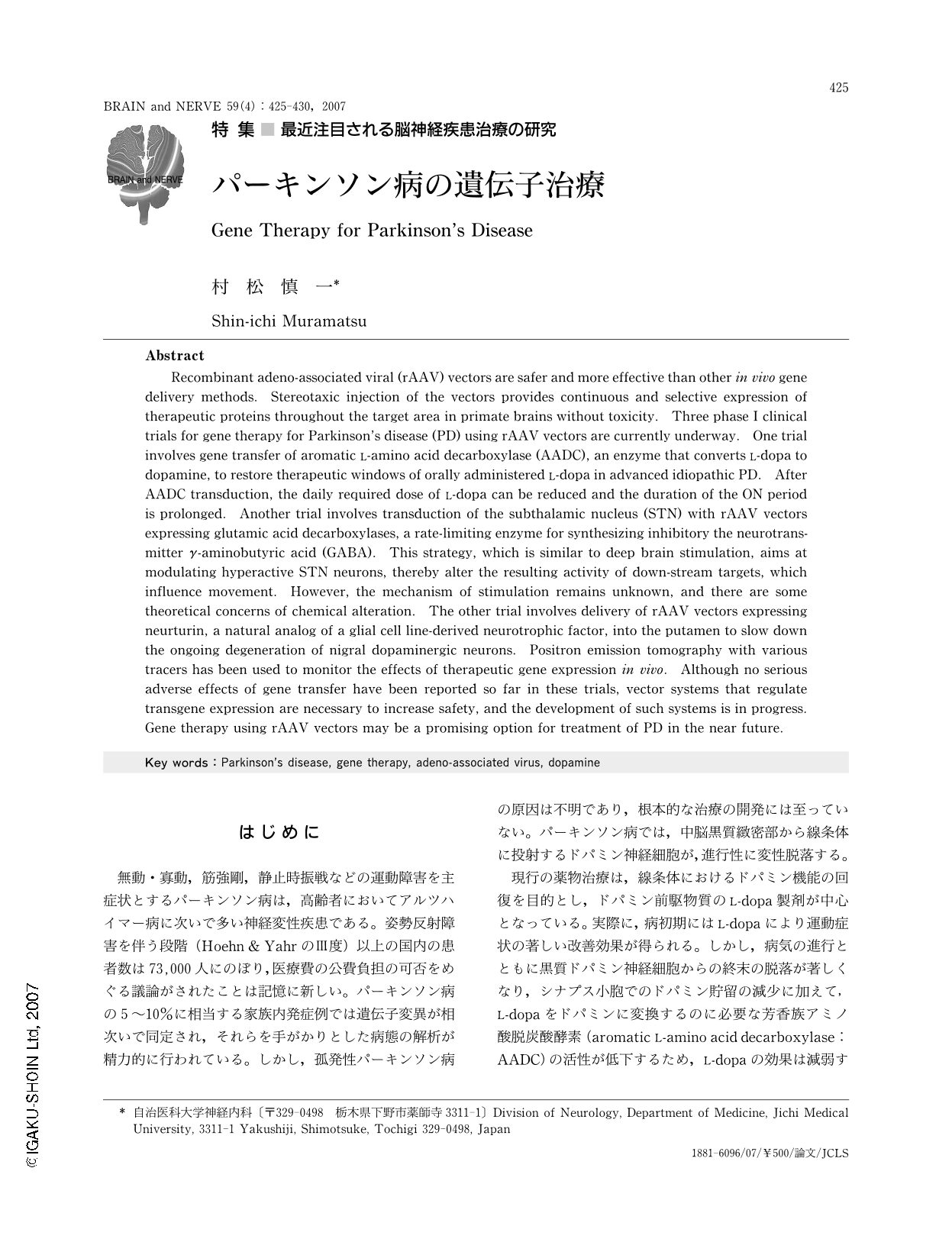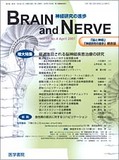Japanese
English
- 有料閲覧
- Abstract 文献概要
- 1ページ目 Look Inside
- 参考文献 Reference
はじめに
無動・寡動,筋強剛,静止時振戦などの運動障害を主症状とするパーキンソン病は,高齢者においてアルツハイマー病に次いで多い神経変性疾患である。姿勢反射障害を伴う段階(Hoehn & YahrのⅢ度)以上の国内の患者数は73,000人にのぼり,医療費の公費負担の可否をめぐる議論がされたことは記憶に新しい。パーキンソン病の5~10%に相当する家族内発症例では遺伝子変異が相次いで同定され,それらを手がかりとした病態の解析が精力的に行われている。しかし,孤発性パーキンソン病の原因は不明であり,根本的な治療の開発には至っていない。パーキンソン病では,中脳黒質緻密部から線条体に投射するドパミン神経細胞が,進行性に変性脱落する。
現行の薬物治療は,線条体におけるドパミン機能の回復を目的とし,ドパミン前駆物質のL-dopa製剤が中心となっている。実際に,病初期にはL-dopaにより運動症状の著しい改善効果が得られる。しかし,病気の進行とともに黒質ドパミン神経細胞からの終末の脱落が著しくなり,シナプス小胞でのドパミン貯留の減少に加えて,L-dopaをドパミンに変換するのに必要な芳香族アミノ酸脱炭酸酵素(aromatic L-amino acid decarboxylase:AADC)の活性が低下するため,L-dopaの効果は減弱する。ドパミン受容体作動薬も使用されるが,L-dopaほど効果が強くなく,運転中の事故にもつながる睡眠発作や,随伴するセロトニン(5-HT2B)受容体刺激作用との関連が示唆される心臓弁膜症の発症率増加が報告されている1)。
遺伝子治療は,治療用の遺伝子を目的の細胞に導入し発現させることにより機能回復を図る。脳内の神経細胞に遺伝子導入するため,さまざまな方法が試みられてきたが,アデノ随伴ウイルス(adeno-associated virus:AAV)に由来するベクターが開発されたことにより,臨床応用が現実的となってきた2)。パーキンソン病に対する遺伝子治療として,AAVベクターを使用した3種類の異なる戦略による臨床研究が米国で開始されている(Table)。
Abstract
Recombinant adeno-associated viral (rAAV) vectors are safer and more effective than other in vivo gene delivery methods. Stereotaxic injection of the vectors provides continuous and selective expression of therapeutic proteins throughout the target area in primate brains without toxicity. Three phase I clinical trials for gene therapy for Parkinson's disease (PD) using rAAV vectors are currently underway. One trial involves gene transfer of aromatic L-amino acid decarboxylase (AADC), an enzyme that converts L-dopa to dopamine, to restore therapeutic windows of orally administered L-dopa in advanced idiopathic PD. After AADC transduction, the daily required dose of L-dopa can be reduced and the duration of the ON period is prolonged. Another trial involves transduction of the subthalamic nucleus (STN) with rAAV vectors expressing glutamic acid decarboxylases, a rate-limiting enzyme for synthesizing inhibitory the neurotransmitter γ-aminobutyric acid (GABA). This strategy, which is similar to deep brain stimulation, aims at modulating hyperactive STN neurons, thereby alter the resulting activity of down-stream targets, which influence movement. However, the mechanism of stimulation remains unknown, and there are some theoretical concerns of chemical alteration. The other trial involves delivery of rAAV vectors expressing neurturin, a natural analog of a glial cell line-derived neurotrophic factor, into the putamen to slow down the ongoing degeneration of nigral dopaminergic neurons. Positron emission tomography with various tracers has been used to monitor the effects of therapeutic gene expression in vivo. Although no serious adverse effects of gene transfer have been reported so far in these trials, vector systems that regulate transgene expression are necessary to increase safety, and the development of such systems is in progress. Gene therapy using rAAV vectors may be a promising option for treatment of PD in the near future.

Copyright © 2007, Igaku-Shoin Ltd. All rights reserved.


